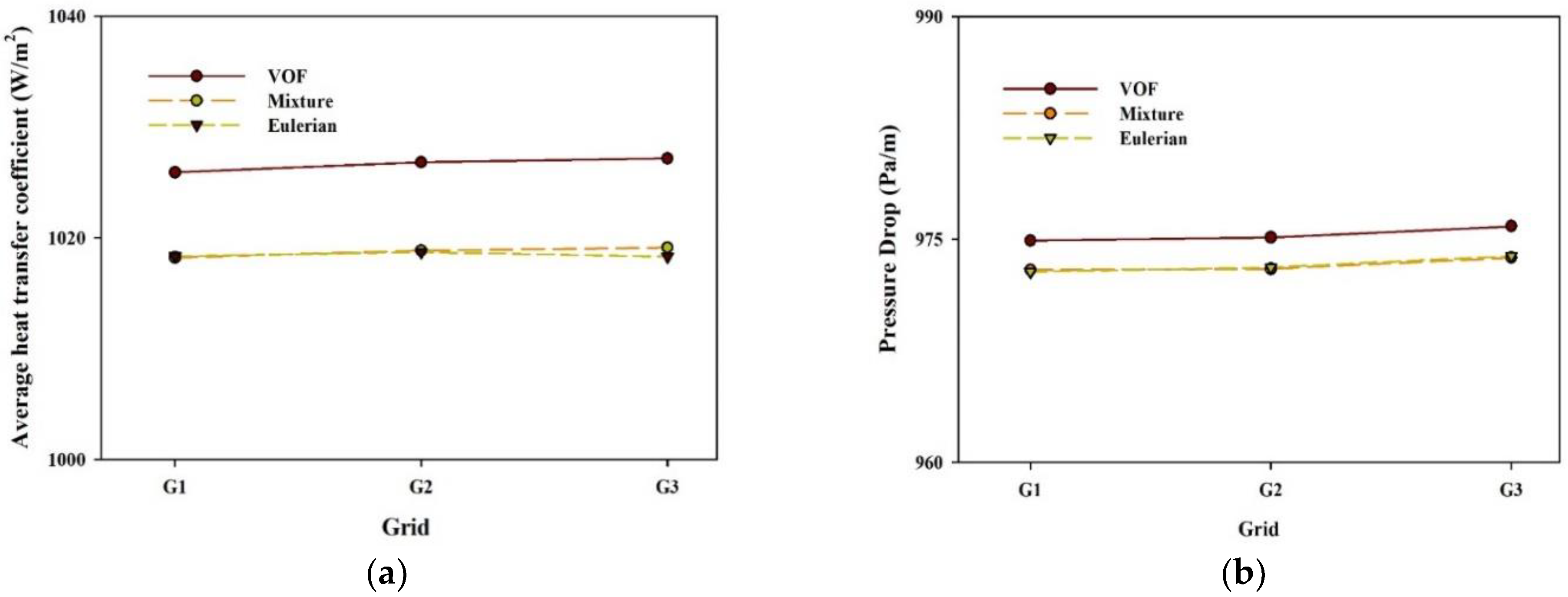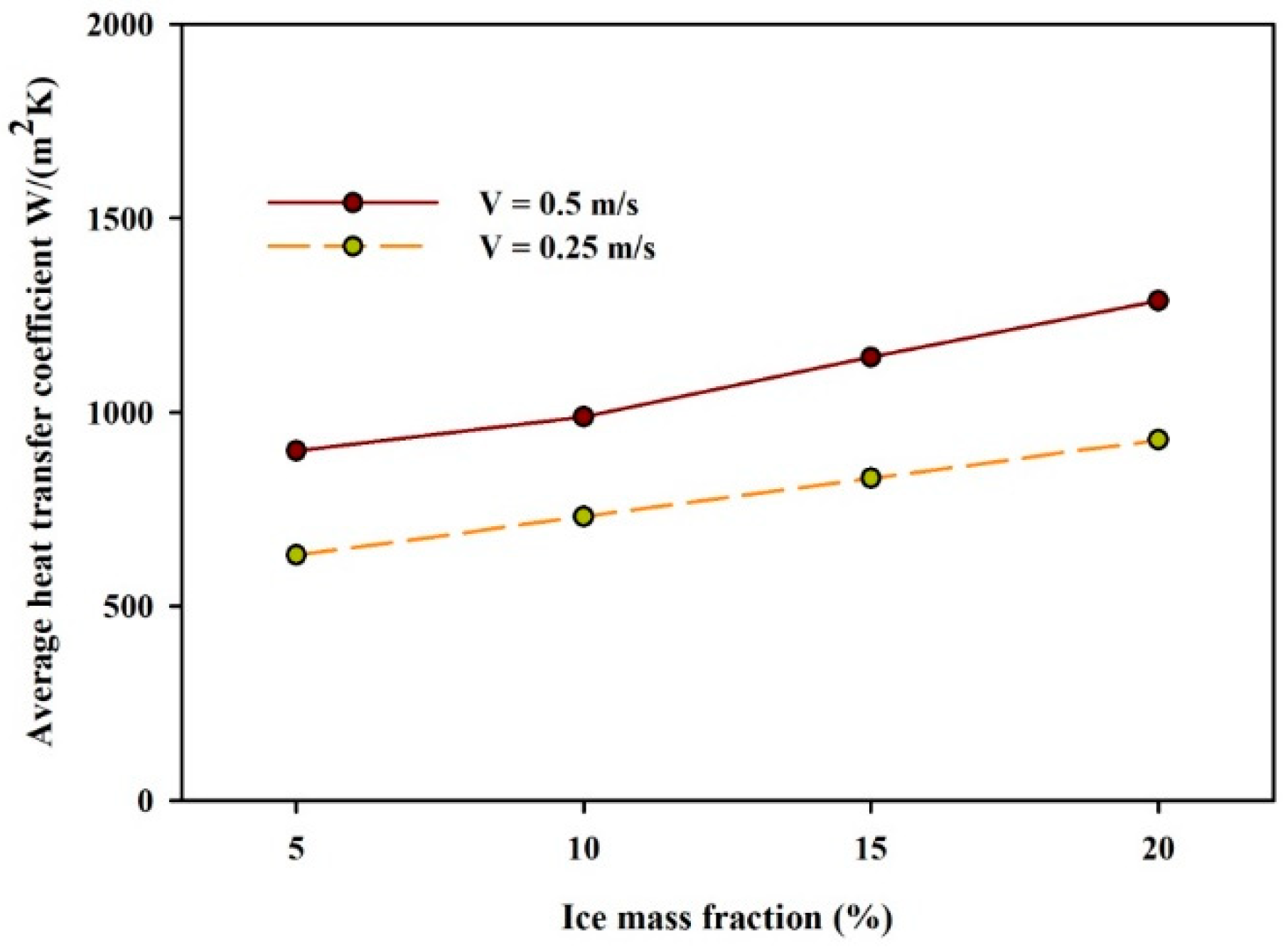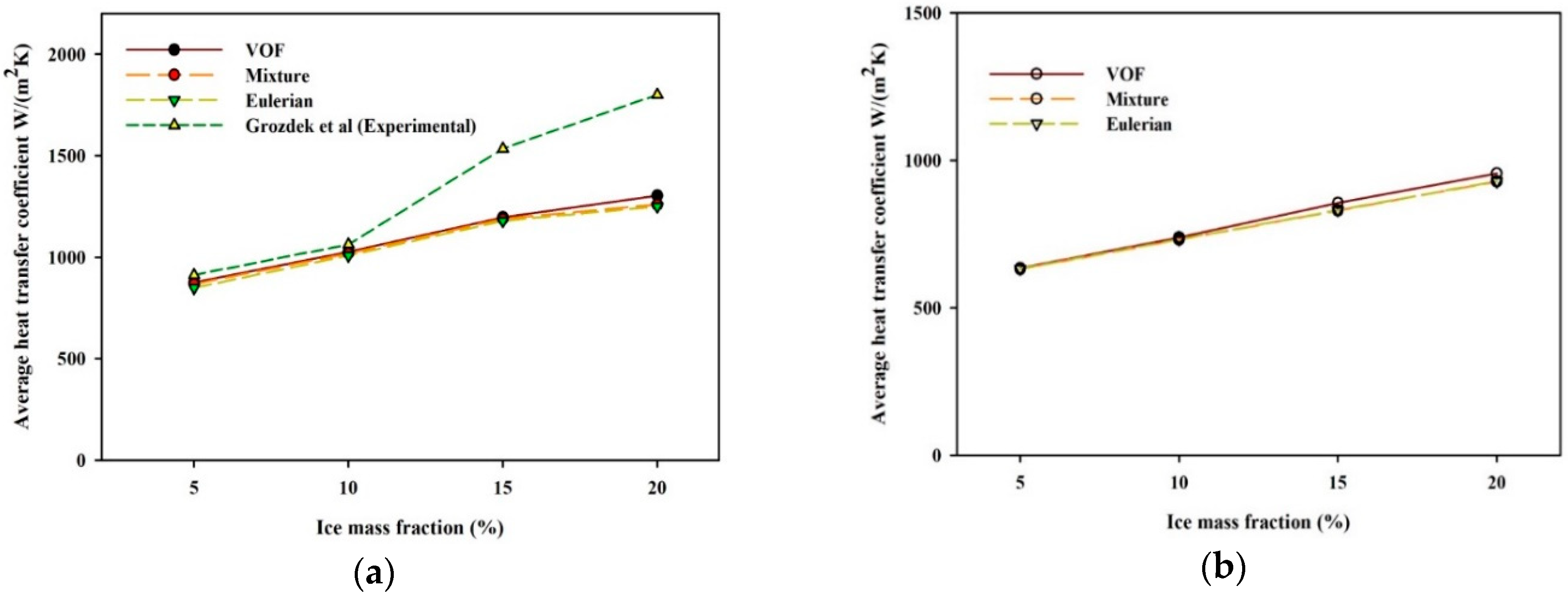Thermo-Fluidic Characteristics of Two-Phase Ice Slurry Flows Based on Comparative Numerical Methods
Abstract
1. Introduction
2. Problem Description and Modelling
2.1. Thermo-Physical Properties
2.2. Single-Phase Flow Modelling
2.3. Two-Phase Flow Modelling
2.3.1. VOF Model
2.3.2. Mixture Model
2.3.3. Eulerian–Eulerian Model
3. Numerical Details
4. Results and Discussion
4.1. Single-Phase Flow
4.2. Non- Isothermal Ice Slurry Flow
4.3. Isothermal Ice Slurry Flow
5. Conclusions
- The heat transfer coefficient of two-phase flow dominates over that of the single-phase flow and exhibits a strong dependence on inlet velocity and ice mass fraction.
- The thermal fields predicted by all numerical models showed a reasonable agreement with the experimental data at low ice mass fractions.
- In contrast to the other models (mixture and Eulerian), the thermal predictions of volume of the fraction model are most consistent with experimental results, with maximum error of ~20% at an ice mass fraction of 20%.
- All the Eulerian–Eulerian models seem quite reasonable in predicting pressure drop for isothermal ice slurry flow, and the maximum error from experimental results is limited to ~15%.
- The multiphase mixture and Eulerian model almost yield the same results (with a maximum relative error of 1%) and seems acceptable in predicting the multiphase characteristics of ice slurry, where both the solid and liquid phases are solved separately. However, in terms of computation cost the Eulerian–Eulerian model is more expensive in comparison to the mixture model due to the large number of equations involved.
Author Contributions
Funding
Conflicts of Interest
Nomenclature
| pipe length, m | sensible enthalpy, J/kg | ||
| concentration (% by weight) | drift velocity, m/s | ||
| Specific heat, J/(kg. K) | slip velocity, m/s | ||
| particle diameter, (m) | local velocity, m/s | ||
| pipe diameter, m | volume of fluid model, (-) | ||
| inlet velocity, m/s | unit vector | ||
| hydraulic diameter, m | Greek Symbols | ||
| drag force coefficient, (-) | dynamic viscosity, Pa.s | ||
| CL | lift force coefficient, (-) | density, kg/ m3 | |
| particle-particle restitution coefficient, (-) | volume fraction, (-) | ||
| radial distribution coefficient, (-) | thermal conductivity, W/(m.K) | ||
| momentum exchange coefficient, (-) | shear stress, Pa | ||
| average heat transfer coefficient, W/(m2.K) | granular temperature, K | ||
| particle liquid heat transfer, W/(m2.K) | bulk viscosity, Pa.s | ||
| temperature, K | Subscripts | ||
| force, N | liquid phase; aqueous solution | ||
| FL | lift force, N | solid phase; ice particles | |
| average Nusselt number, (-) | ice slurry | ||
| heat flux, W/m2 | interaction among solid particles | ||
| Reynolds number, (-) | effective | ||
| mass transfer rate, kg/(m3.s) | mixture | ||
| gravitational acceleration, m/s2 | interaction between solid liquid phases | ||
| pressure, Pa | phase index | ||
| latent heat, J/kg | inlet | ||
| temperature difference, K | lift | ||
| drag | |||
References
- Sarafraz, M.M.; Pourmehran, O.; Yang, B.; Arjomandi, M.; Ellahi, R. Pool Boiling Heat Transfer Characteristics of Iron Oxide Nano-Suspension under Constant Magnetic Field. Int. J. Therm. Sci. 2020, 147. [Google Scholar] [CrossRef]
- Kauffeld, M.; Wang, M.J.; Goldstein, V.; Kasza, K.E. Ice Slurry Applications. Int. J. Refrig. 2010, 33, 1491–1505. [Google Scholar] [CrossRef] [PubMed]
- Onokoko, L.; Poirier, M.; Galanis, N.; Poncet, S. Experimental and Numerical Investigation of Isothermal Ice Slurry Flow. Int. J. Therm. Sci. 2018, 126, 82–95. [Google Scholar] [CrossRef]
- Akbarzadeh, M.; Rashidi, S.; Karimi, N.; Ellahi, R. Convection of Heat and Thermodynamic Irreversibilities in Two-Phase, Turbulent Nanofluid Flows in Solar Heaters by Corrugated Absorber Plates. Adv. Powder Technol. 2018, 29, 2243–2254. [Google Scholar] [CrossRef]
- Yousif, M.A.; Ismael, H.F.; Abbas, T.; Ellahi, R. Numerical Study of Momentum and Heat Transfer of Mhd Carreau Nanofluid over an Exponentially Stretched Plate with Internal Heat Source/Sink and Radiation. Heat Transf. Res. 2019, 50, 649–658. [Google Scholar] [CrossRef]
- Mi, S.; Cai, L.; Ma, K.; Liu, Z. Investigation on Flow and Heat Transfer Characteristics of Ice Slurry without Additives in a Plate Heat Exchanger. Int. J. Heat Mass Transf. 2018, 127, 11–20. [Google Scholar] [CrossRef]
- Kumano, H.; Asaoka, T.; Sawada, S. Effect of Initial Aqueous Solution Concentration and Heating Conditions on Heat Transfer Characteristics of Ice Slurry. Int. J. Refrig. 2014, 41, 72–81. [Google Scholar] [CrossRef]
- Kumano, H.; Yamanada, Y.; Makino, Y.; Asaoka, T. Effect of Initial Aqueous Solution Concentration on Rheological Behavior of Ice Slurry. Int. J. Refrig. 2016, 68, 218–225. [Google Scholar] [CrossRef]
- Kamyar, A.; Aminossadati, S.M.; Leonardi, C.R. Thermo-Hydrodynamics of a Helical Coil Heat Exchanger Operated with a Phase-Change Ice Slurry as a Refrigerant. Heat Transf. Eng. 2019, 40, 283–294. [Google Scholar] [CrossRef]
- Egolf, P.W.; Kauffeld, M.; Kawaij, M. Handbook on Ice Slurries—Fundamentals and Engineering. Int. Inst. Refrig. Paris 2005, 359, 259–263. [Google Scholar]
- Onokoko, C.L.; Galanis, N.; Poncet, S.; Poirier, M. Heat Transfer of Ice Slurry Flows in a Horizontal Pipe: A Numerical Study. Int. J. Therm. Sci. 2019, 142, 54–67. [Google Scholar] [CrossRef]
- Mahmood, A.; Md Basir, M.; Ali, U.; Mohd Kasihmuddin, M.; Mansor, M. Numerical Solutions of Heat Transfer for Magnetohydrodynamic Jeffery-Hamel Flow Using Spectral Homotopy Analysis Method. Processes 2019, 7, 626. [Google Scholar] [CrossRef]
- Lee, J.J.; Kim, H.J.; Kim, D.K. Experimental Study on Forced Convection Heat Transfer from Plate-Fin Heat Sinks with Partial Heating. Processes 2019, 7, 772. [Google Scholar] [CrossRef]
- Lee, D.W.; Yoon, E.S.; Joo, M.C.; Sharma, A. Heat Transfer Characteristics of the Ice Slurry at Melting Process in a Tube Flow. Int. J. Refrig. 2006, 29, 451–455. [Google Scholar] [CrossRef]
- Kumano, H.; Hirata, T.; Shouji, R.; Shirakawa, M. Experimental Study on Heat Transfer Characteristics of Ice Slurry. Int. J. Refrig. 2010, 33, 1540–1549. [Google Scholar] [CrossRef]
- Lee, D.W.; Sharma, A. Melting of Ice Slurry in a Tube-in-Tube Heat Exchanger. Int. J. Energy Res. 2006, 30, 1013–1021. [Google Scholar] [CrossRef]
- Knodel, B.D.; France, D.M.; Choi, U.S.; Wambsganss, M.W. Heat Transfer and Pressure Drop in Ice-Water Slurries. Appl. Therm. Eng. 2000, 20, 671–685. [Google Scholar] [CrossRef]
- Stamatiou, E.; Kawaji, M. Thermal and Flow Behavior of Ice Slurries in a Vertical Rectangular Channel-Part II. Forced Convective Melting Heat Transfer. Int. J. Heat Mass Transf. 2005, 48, 3544–3559. [Google Scholar] [CrossRef]
- Jensen, E.N.; Christensen, K.G.; Hansen, T.M.; Schneider, P.; Kauffeld, M. Pressure Drop and Heat Transfer with Ice Slurry. Sci. Tech. Du Froid 2001, 1, 572–580. [Google Scholar]
- Bordet, A.; Poncet, S.; Poirier, M.; Galanis, N. Flow Visualizations and Pressure Drop Measurements of Isothermal Ice Slurry Pipe Flows. Exp. Therm. Fluid Sci. 2018, 99, 595–604. [Google Scholar] [CrossRef]
- Monteiro, A.C.S.; Bansal, P.K. Pressure Drop Characteristics and Rheological Modeling of Ice Slurry Flow in Pipes. Int. J. Refrig. 2010, 33, 1523–1532. [Google Scholar] [CrossRef]
- Grozdek, M.; Khodabandeh, R.; Lundqvist, P. Experimental Investigation of Ice Slurry Flow Pressure Drop in Horizontal Tubes. Exp. Therm. Fluid Sci. 2009, 33, 357–370. [Google Scholar] [CrossRef]
- Hägg, C. Ice Slurry as Secondary Fluid in Refrigeration Systems. Ph.D. Thesis, KTH Royal Institute of Technology, Stockholm, Sweden, 2005. [Google Scholar]
- Liu, Y.H.; Zhang, E.Z.; Zhao, J.M.; Chen, P.L. Experiment Study on Friction Loss Characteristics of Pipes with Ice Slurry. Sci. Tech. Du Froid 1997, 490–494. [Google Scholar]
- Wang, J.; Battaglia, F.; Wang, S.; Zhang, T.; Ma, Z. Flow and Heat Transfer Characteristics of Ice Slurry in Typical Components of Cooling Systems: A Review. Int. J. Heat Mass Transf. 2019, 141, 922–939. [Google Scholar] [CrossRef]
- He, M.; Li, Z.; Han, X.; Cabassud, M.; Dahhou, B. Development of a Numerical Model for a Compact Intensified Heat-Exchanger/Reactor. Processes 2019, 7, 454. [Google Scholar] [CrossRef]
- Wang, C.; Hu, B.; Zhu, Y.; Wang, X.; Luo, C.; Cheng, L. Numerical Study on the Gas-Water Two-Phase Flow in the Self-Priming Process of Self-Priming Centrifugal Pump. Processes 2019, 7, 330. [Google Scholar] [CrossRef]
- Li, L.; Sheng, G.; Su, Y. Water-Gas Two-Phase Flow Behavior of Multi-Fractured Horizontal Wells in Shale Gas Reservoirs. Processes 2019, 7, 664. [Google Scholar] [CrossRef]
- ANSYS FLUENT Theory Guide; ANSYS Inc.: Canonsburg, PA, USA, 2013; pp. 468–542.
- Bhatti, M.M.; Zeeshan, A.; Ellahi, R.; Bég, O.A.; Kadir, A. Effects of Coagulation on the Two-Phase Peristaltic Pumping of Magnetized Prandtl Biofluid through an Endoscopic Annular Geometry Containing a Porous Medium. Chin. J. Phys. 2019, 58, 222–234. [Google Scholar] [CrossRef]
- Wang, J.; Zhang, T.; Wang, S. Heterogeneous Ice Slurry Flow and Concentration Distribution in Horizontal Pipes. Int. J. Heat Fluid Flow 2013, 44, 425–434. [Google Scholar] [CrossRef]
- Wang, J.; Wang, S.; Zhang, T.; Liang, Y. Numerical Investigation of Ice Slurry Isothermal Flow in Various Pipes. Int. J. Refrig. 2013, 36, 70–80. [Google Scholar] [CrossRef]
- Zhang, P.; Shi, X.J. Thermo-Fluidic Characteristics of Ice Slurry in Horizontal Circular Pipes. Int. J. Heat Mass Transf. 2015, 89, 950–963. [Google Scholar] [CrossRef]
- Wang, J.; Wang, S.; Zhang, T.; Battaglia, F. Mathematical and Experimental Investigation on Pressure Drop of Heterogeneous Ice Slurry Flow in Horizontal Pipes. Int. J. Heat Mass Transf. 2017, 108, 2381–2392. [Google Scholar] [CrossRef]
- Rawat, K.S.; Pratihar, A.K. Numerical Investigation of Ice Slurry Flow in a Horizontal Pipe. IOP Conf. Ser. Mater. Sci. Eng. 2018, 310. [Google Scholar] [CrossRef]
- Yadav, S.K.; Ziyad, D.; Kumar, A. Numerical Investigation of Isothermal and Non-Isothermal Ice Slurry Flow in Horizontal Elliptical Pipes. Int. J. Refrig. 2019, 97, 196–210. [Google Scholar] [CrossRef]
- Cai, L.; Liu, Z.; Mi, S.; Luo, C.; Ma, K.; Xu, A.; Yang, S. Investigation on Flow Characteristics of Ice Slurry in Horizontal 90° Elbow Pipe by a CFD-PBM Coupled Model. Adv. Powder Technol. 2019, 30, 2299–2310. [Google Scholar] [CrossRef]
- Grozdek, M.; Khodabandeh, R.; Lundqvist, P.; Palm, B.; Melinder, Å. Experimental Investigation of Ice Slurry Heat Transfer in Horizontal Tube. Int. J. Refrig. 2009, 32, 1310–1322. [Google Scholar] [CrossRef]
- Melinder, Å. Properties and Other Aspects of Aqueous Solutions Used for Single Phase and Ice Slurry Applications. Int. J. Refrig. 2010, 33, 1506–1512. [Google Scholar] [CrossRef]
- Melinder, Å. Thermophysical Properties of Aqueous Solutions Used as Secondary Working Fluids. Ph.D. Thesis, The Royal Institute of Technology KTH, Stockholm, Sweden, 2007. [Google Scholar]
- Li, C.; Wu, W.; Liu, Y.; Hu, C.; Zhou, J. Analysis of Air–Oil Flow and Heat Transfer inside a Grooved Rotating-Disk System. Processes 2019, 7, 632. [Google Scholar] [CrossRef]
- Jiao, W.; Cheng, L.; Xu, J.; Wang, C. Numerical Analysis of Two-Phase Flow in the Cavitation Process of AWaterjet Propulsion Pump System. Processes 2019, 7, 690. [Google Scholar] [CrossRef]
- Taivassalo, V.; Kallio, S. On the Mixture Model for Multiphase Flow. VTT Publ. 1996, 288, 3–67. [Google Scholar]
- Schiller, L. A Drag Coefficient Correlation. Zeit. Ver. Deutsch. Ing. 1933, 77, 318–320. [Google Scholar]
- Gidaspow, D. Multiphase Flow and Fluidization: Continuum and Kinetic Theory Descriptions; Academic Press: Cambridge, MA, USA, 1994. [Google Scholar]
- Lun, C.K.K.; Savage, S.B.; Jeffrey, D.J.; Chepurniy, N. Kinetic Theories for Granular Flow: Inelastic Particles in Couette Flow and Slightly Inelastic Particles in a General Flowfield. J. Fluid Mech. 1984, 140, 223–256. [Google Scholar] [CrossRef]
- Kakac, S.; Shah, R.K.; Aung, W. Handbook of Single-Phase Convective Heat Transfer; John Wiley and Sons Inc.: New York, NY, USA, 1987. [Google Scholar]
- Niezgoda-Zelasko, B. Heat Transfer of Ice Slurry Flows in Tubes. Int. J. Refrig. 2006, 29, 437–450. [Google Scholar] [CrossRef]
- Lee, D.W.; Yoon, C.I.; Yoon, E.S.; Joo, M.C. Experimental Study on Flow and Pressure Drop of Ice Slurry for Various Pipes. In Proceedings of the 5th Workshop on Ice-Slurries of the International Institute of Refrigeration, Stockholm, Sweden, 30–31 May 2002. [Google Scholar]







| Properties | Expression | Value | |
|---|---|---|---|
| Aqueous sol. (10.3%) | Density | 987 kg/m3 | |
| Viscosity | 5.032 × 10−3 Pa.s | ||
| Thermal Cond. | 0.5034 W/(m.K) | ||
| Specific heat | 4260 J/(kg.K) | ||
| Ice particles | Density | 917 kg/m3 | |
| Thermal Cond. | 2.26 W/(m.K) | ||
| Specific heat | 2156 J/(kg.K) | ||
| Latent heat | - | 332,400J/kg |
| Flow | Ceth (%) | CIce (%) | q (W/m2) | V (m/s) |
|---|---|---|---|---|
| Single-phase flow | 10.3 | 0 | 4000; 16,000 | 0.1; 0.2; 0.3; 0.4 |
| Non-isothermal ice slurry flow | 10.3 | 5–20 | 4000 | 0.25; 0.5 |
| Isothermal ice slurry flow | 10.3 | 5–15 | - | 0.1–1.2 |
© 2019 by the authors. Licensee MDPI, Basel, Switzerland. This article is an open access article distributed under the terms and conditions of the Creative Commons Attribution (CC BY) license (http://creativecommons.org/licenses/by/4.0/).
Share and Cite
Akhtar, S.; Ali, H.; Park, C.W. Thermo-Fluidic Characteristics of Two-Phase Ice Slurry Flows Based on Comparative Numerical Methods. Processes 2019, 7, 898. https://doi.org/10.3390/pr7120898
Akhtar S, Ali H, Park CW. Thermo-Fluidic Characteristics of Two-Phase Ice Slurry Flows Based on Comparative Numerical Methods. Processes. 2019; 7(12):898. https://doi.org/10.3390/pr7120898
Chicago/Turabian StyleAkhtar, Shehnaz, Haider Ali, and Cheol Woo Park. 2019. "Thermo-Fluidic Characteristics of Two-Phase Ice Slurry Flows Based on Comparative Numerical Methods" Processes 7, no. 12: 898. https://doi.org/10.3390/pr7120898
APA StyleAkhtar, S., Ali, H., & Park, C. W. (2019). Thermo-Fluidic Characteristics of Two-Phase Ice Slurry Flows Based on Comparative Numerical Methods. Processes, 7(12), 898. https://doi.org/10.3390/pr7120898






